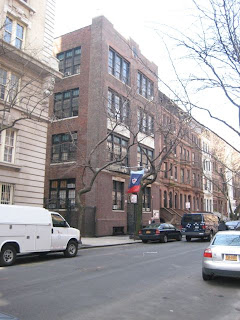There were so many great ideas that I picked up while I was there. Here are a few highlights:
1. Genius Hour
The first class I visited was 4B, led by the dynamic Sharik/Beddows combination. In the class there were also 3 Aussie kids, including one Saints fan! (Go the Saints!)Anyway, 4B was launching into their "Genius Hour", based on work by Dan Pink (who else?).
Genius Hour in 4B gave the kids an opportunity to explore some maths concepts in creative ways. In this case, they were presented with a provocative scenario - move all the classroom furniture to a new classroom upstairs - and then told all the rulers and tape measures had already been packed up and taken.
Using informal measurements, the kids explored how they were going to determine the sizes of various large pieces of furniture.
Some very interesting conversations evolved. My favourite comment was from a young boy who was measuring a table using paper clips and drinking straws.
"Will the length (of the desk) be different if I use different materials?"
Here is a link to some ideas describing what some teachers are doing for their "Genius Hour"
2. Meaningful Links Across Disciplines
Next stop was a visit to 5th Grade and the amazing Posner/Watson team. The class was currently inquirying into elements and compounds that make up the world around us.
The maths activity really was an extension of their inquiry. It started with a simple discussion of H2O and the ratio of hydrogen to oxygen. This ratio was expressed as a fraction.
The kids then saw that they could explore a range of other compounds in a similar way and set to work identifying the elements in various compounds and what fraction of the whole each element was.
When I left, they were happy investigating - engaged and motivated because the work they were doing made sense, was relevant and had meaning for them - because it linked to other learning across curriculum boundaries.
3. Require Multiple Solutions
In 2B, they were learning about 2-digit addition. Very cleverly, the teacher had disguised this as a lesson about playing with money.
A very significant part of this lesson was that, when children were required to show what coins they needed to make a certain total, they were required to do it in multiple ways. Simple but critically important to demonstrate depth of understanding.
4. Publish an Assessment Rubric
Still in 2B, while the lesson was progressing, the teacher had displayed on the Smartboard a copy of the assessment rubric. The children had obviously been briefed on the rubric as they constantly referred back to it in their discussions.
"Do we need to do that?"
"Yes - it says on the rubric!"
If the kids are told explicitly what is expected, they will be able to monitor and direct their own learning.
5. Reflection
One thing I was very aware of at Dwight was the importance that the school placed on "reflection". This was certainly true of children in all classes, where they were encouraged to reflect on the learning process, the strategies that they used and their efficiency and effectiveness.
But reflection was also practised by the staff. In my discussions with the staff, it was obvious that they thought a lot about what they did and how they did it. Not satisfied with simply maintaining the same level of quality as in previous years, there was much discussion about how things could be improved, tweeked, supplemented and augmented to do even better.
In the words of Churchill, "To improve is to change, to be perfect is to change often."





No comments:
Post a Comment
Any comments you would like to make?